Miss Dally’s Boarding House: Part III
Recently discovered receipts and tax records from Miss Dally’s boarding house
The name Mary Dally/Dalley has largely been lost to history. By contrast, Gouverneur Morris is widely acknowledged to be the “penman” of the Constitution. Thus, the location where Gouverneur Morris boarded in 1787 is not merely an academic question. To the contrary, the recently discovered evidence that Gouverneur Morris boarded with Miss Dally is the key to unlocking one of the most overlooked addresses in American history: the location where the U.S. Constitution – and the Preamble – were “drafted” in September of 1787.
Just as Thomas Jefferson was selected by a five-member committee to draft the Declaration of Independence in 1776, Gouverneur Morris was selected by the five-member Committee of Style in September of 1787 to draft the final version of the Constitution. For many years historians suspected (but lacked proof) that Gouverneur Morris boarded with Miss Mary Dally during the Constitutional Convention. As recently announced by StatutesandStories.com, we now have confirmation that Gouverneur Morris was in fact boarding with Miss Dally on Market Street between Second and Third streets in Philadelphia.
This blog post – Miss Dally Part III – is the third installment of a multi-part series based on years of archival research. Part I discusses the discovery that Gouverneur Morris made nearly two dozen payments to Miss Dally from 1782 through January of 1788. Yet, these payments reflected in Gouverneur Morris’ bank records at the Library of Congress do not identify the reason for the payments, only the monetary amount, date and payee.
Part II focuses on Miss Dally and her boarding house which catered to members of Congress for over a decade. Indeed, during the Revolutionary War Miss Dally’s boarding house was appropriately referred to by Congressman William Whipple as “Liberty Hall.” As discussed in Part II, Mary Dally was also an entrepreneurial businesswoman who began selling several varieties of imported tea from China in 1789. Years later, Miss Dally educated “young ladies” at the prestigious Bordenton Academy.
Part III resolves unanswered questions raised by Gouverneur Morris’ bank records. Thankfully the City of Philadelphia kept detailed records of its tax receipts during and after the Revolutionary War. These tax records provide further proof connecting Miss Dally and Gouverneur Morris. While Gouverneur Morris frequently traveled on business, his name appears alongside Miss Dally’s name in the Philadelphia tax rolls in 1781, 1786 and 1787. These records, recently located in the Pennsylvania State Archives, suggest that Gouverneur Morris was a loyal tenant of Miss Dally for extended periods when he lived in Philadelphia.
While Miss Dally operated her boarding house for approximately two decades, she did not own the building. Nevertheless, the Philadelphia tax rolls make clear that Miss Dally paid the annual real estate tax on behalf of the owner, Bartholomew Wister. Further investigation has revealed that Mr. Wister was a prominent Quaker who was elected to the Pennsylvania Society for Promoting the Abolition of Slavery in April of 1787.
This discovery that Miss Dally is closely connected with a prominent Philadelphia abolitionist raises intriguing questions of its own. For example, Ben Franklin, his grandson William Temple Frankin, and Thomas Paine were also elected to the Society in April of 1787, the month before the Constitutional Convention met in Philadelphia. According to James Madison’s notes, Gouverneur Morris was an outspoken opponent of slavery at the Constitutional Convention, referring to slavery as a “nefarious institution” and “the curse of heaven on the states where it prevailed.” It is thus no surprise that Gouverneur Morris boarded with Miss Dally.
Part III also discusses detailed receipts and Congressional expense reports involving Miss Dally created in the late 1770s and early 1780s. These primary sources document payments to Miss Dally by members of the Massachusetts delegation to Congress. Sam Adams, Artemas Ward and Samuel Holten submitted these receipts to the Massachusetts Comptroller’s Office to obtain reimbursement for their Philadelphia expenses. These records were located in the Massachusetts State Archives and are copied below along with the Philadelphia tax rolls.
Philadelphia tax records
Mary Dally’s name first appears in the Philadelphia tax rolls beginning in 1780. Miss Dally and her unnamed “sisters” initially operated their boarding house in a building they rented from Thomas Mifflin. As illustrated in the following chart, the Mifflin property was located in the Walnut Ward where Miss Dally operated her boarding house for approximately two years (1780 and 1781).
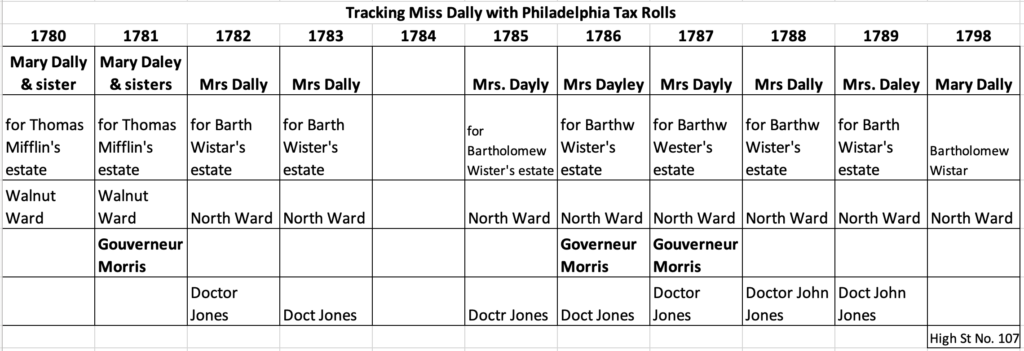
Gouverneur Morris and his personal doctor and friend, John Jones, are listed as boarders/sub-tenants in the tax roll for 1781. The property owner, Thomas Mifflin, would serve as the third President of Congress in 1783 and be elected Speaker of the Pennsylvania House of Representatives in 1785. Coincidentally, Gouverneur Morris and Thomas Mifflin would serve together as delegates at the Constitutional Convention in 1787. Mifflin would be elected the first Governor of Pennsylvania in 1790, succeeding Ben Franklin. It is unclear why Miss Dally moved out of the Mifflin property.
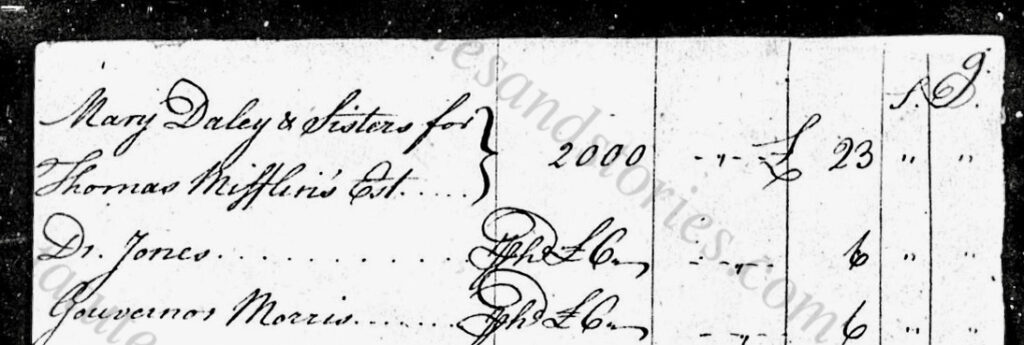
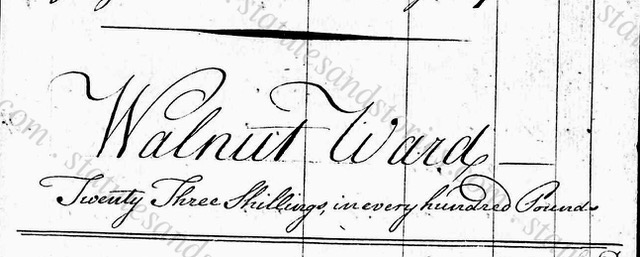
By 1782 Miss Dally had moved her boarding house to Philadelphia’s North Ward where she would remain for approximately two decades. Beginning in 1782, the tax rolls indicate that Miss Dally rented from and was paying taxes on behalf of another prominent Philadelphia land owner, Bartholomew Wister. Gouverneur Morris’ name does not reappear until 1786 and 1787, when he is again listed below Miss Dally’s name along with Doctor Jones.
The tax roll for 1782 is copied below. While Gouverneur Morris’ housing arrangements are unclear in 1782, Doctor Jones remained a boarder and/or sub-tenant of Miss Dally’s for approximately a decade. It is also possible that he operated his medical office out of space that he sublet from Miss Dally. Both Doctor Jones and Gouverneur Morris were transplanted New Yorkers who would have known each other from King’s College when Doctor Jones became the first professor of medicine appointed in 1768.


Gouverneur Morris reappears in the tax records below Miss Dally’s name in 1786. The tax roll for 1786 and 1787 indicate that Gouverneur Morris and Doctor Jones were boarding and/or sub-leasing space from Miss Dally in the same North Ward location. Based on the description contained in Francis White’s street directory we know that Miss Dally’s boarding house was located on Market Street between 2nd and 3rd streets. Click her for a link to Part I which discusses Philadelphia’s first city directories published by Francis White and Captain MacPherson in 1785.
Copied below are the tax rolls for 1786 and 1787 clearly demonstrating that Gouverneur Morris was a long term boarder and/or tenant of Miss Dally’s in the building owned by Bartholomew Wistar. As discussed in Part II, the letters sent by Elbridge Gerry to his wife Ann during the Constitutional Convention indicate that Alexander Hamilton and Elbridge Gerry both boarded with Miss Dally at various times during the Constitutional Convention in 1787.
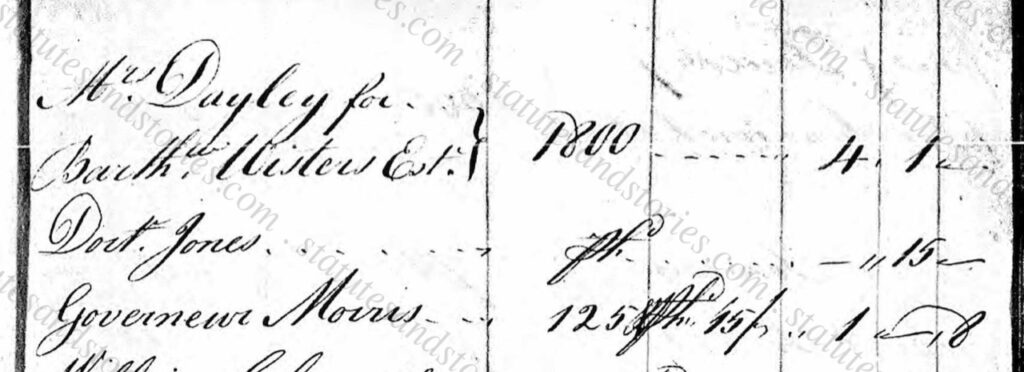
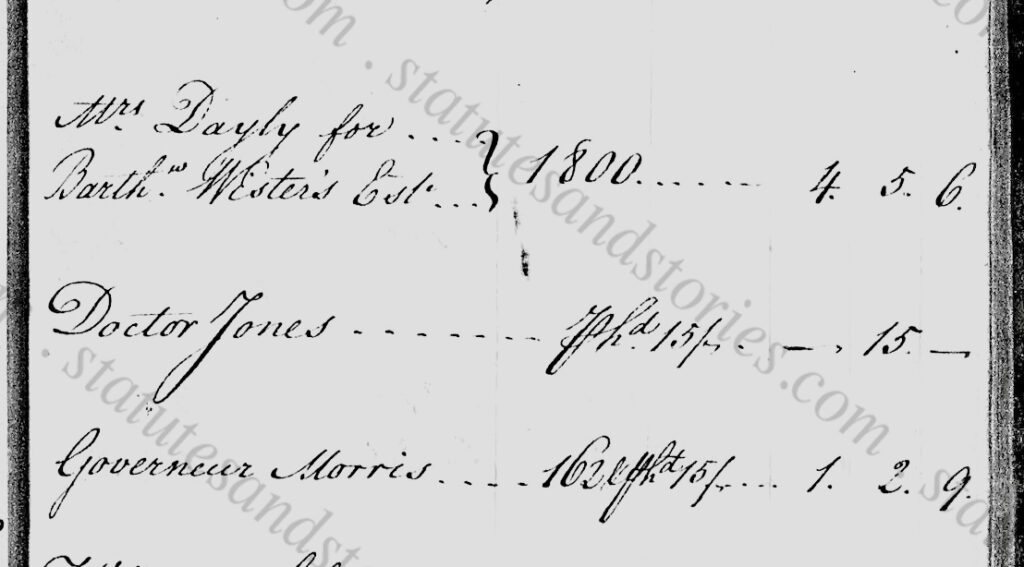
The Constitutional Convention concluded on September 17, 1787. Following the Convention, Gouverneur Morris returned to New York to move into the Morrisania estate which he purchased in March of 1787. Click here for a discussion of the legal settlement and complex financial transactions which enabled Morris to purchase his beloved Morrisania estate after the passing of Morris’ mother Sarah in 1786. Accordingly, one would not expect to see Gouverneur Morris’ name listed in the Philadelphia tax rolls after 1787.
In 1798 Miss Dally was still operating her boarding house out of the same North Ward location owned by Bartholomew Wistar. Importantly, the 1798 tax record is the first tax roll to specifically provide Miss Dally’s address: 107 High Street (which is another name for Market Street). By 1798 the tax forms were prepared using a more detailed reporting format and pre-printed, itemized schedules.
Copied below are two pages from the tax rolls for 1798 (referred to as the “U.S. Direct Tax List” for 1798) indicating that Miss Dally’s 107 High Street location had been owned by Bartholomew Wistar for nearly two decades. While the spelling of Miss Dally’s name fluctuates over time, it is significant that her name was spelled with the same five letters (Dally) used beginning with the 1780 tax roll. Indeed, this is how Elbridge Gerry spelled her name in his letters to Ann Gerry written during the Constitutional Convention in 1787.

The column headings on the “General List” form “D” describe each dwelling house. Miss Dally’s building was a single “Dwelling House” with four “Out Houses.” The square footage of 3,570 square feet listed on form D is noteworthy. James Green from the Library Company of Philadelphia has observed that the lot was potentially 140 feet deep. “So it’s possible that Morris and Jones occupied smaller self-contained houses at the back of the lot, which may also have been their places of business. This was a very common configuration with Philadelphia row houses. Franklin in the 1740s had another such lot, and the back buildings contained his printing office and book store as well as the post office.”
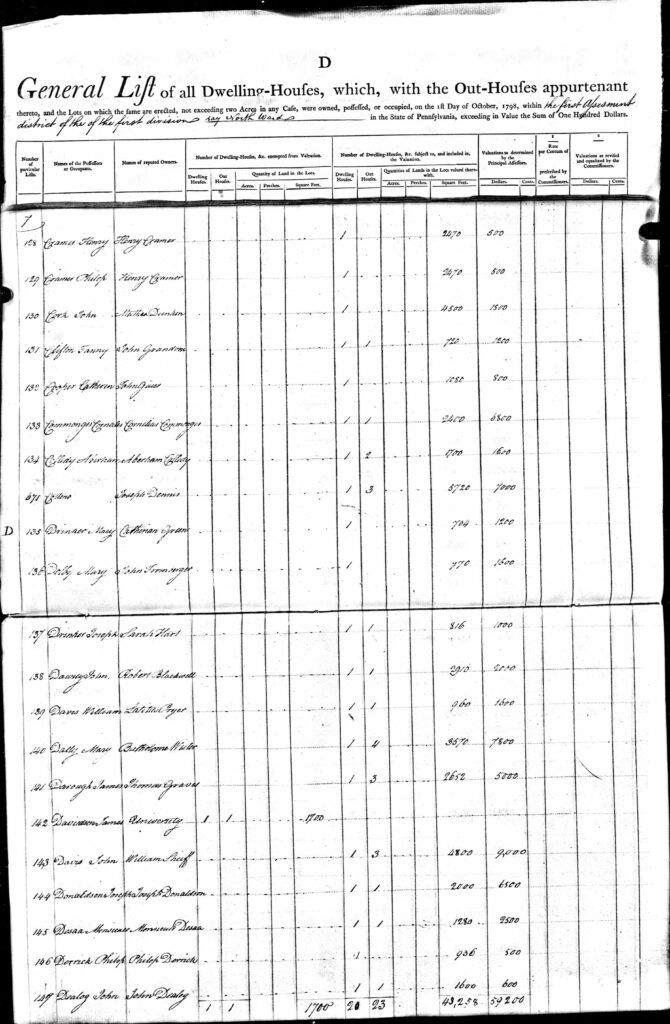
Receipts and expense reports dating back to 1779
As discussed in Part II, the members of the Massachusetts delegation to Congress began boarding with Miss Dally and her sister, Miss Clark, in late 1778. For example, Sam Adams wrote to his wife Betsy on December 13, 1778 indicating that Miss Daily and her sister sent their regards. According to Adams’ letter sent from Philadelphia:
Miss Clark and her Sister Miss Daily in whose house the Massachusetts Delegates are agreeably situated present their respectful Compliments to you.
Sam Adams’ letter is held by the New York Public Library and the above quote text is copied below.

Copied below are receipts and expense reports prepared by Massachusetts delegates Sam Adams, Artemas Ward and Samuel Holten.

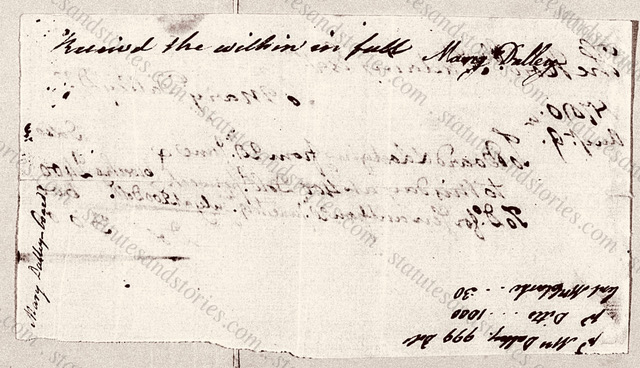
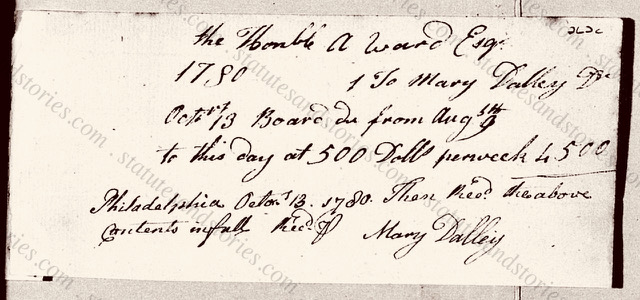

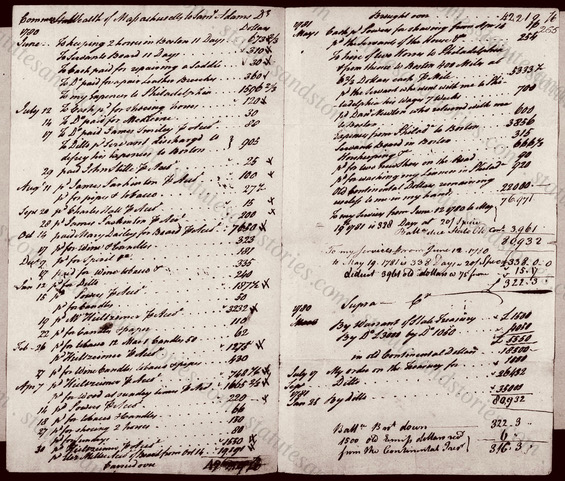
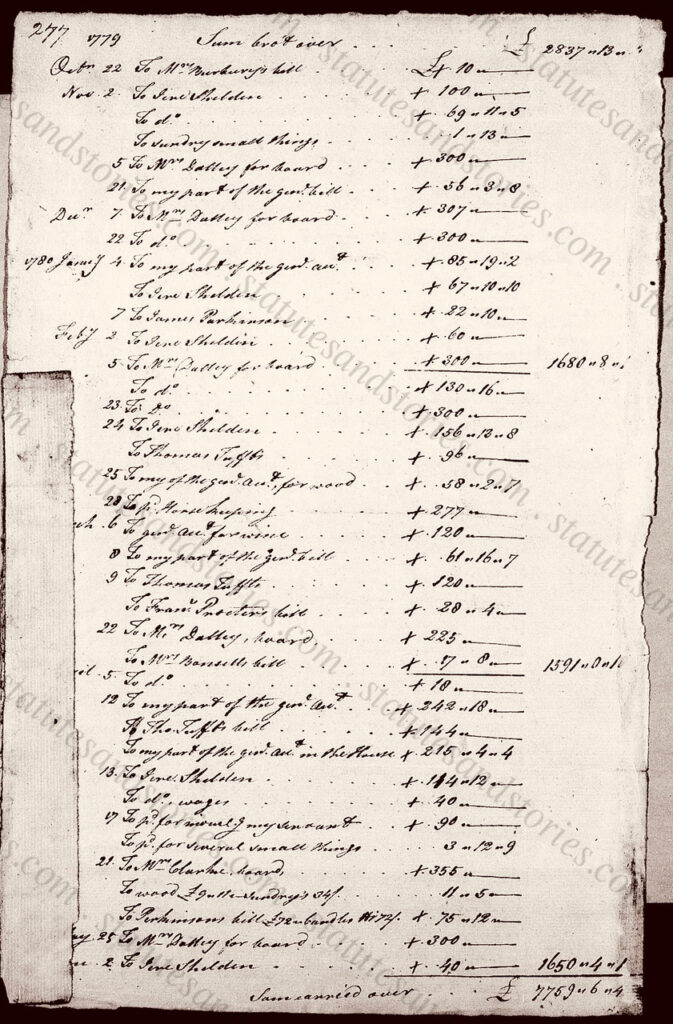

Part IV theorizes that the Committee on Style operated out of Miss Dally’s boarding house between September 8 to September 12 (hereinafter the “Committee on Style Venue Hypothesis”). While there is no direct evidence for the Committee on Style Venue Hypothesis, the body of growing circumstantial evidence suggests that Miss Dally’s boarding house was the most convenient, central location for the Committee on Style to meet when drafting the all-important September 12 draft of the Constitution, which included the Preamble.
Part V examines the limited historical record mentioning Miss Dally. Part V is organized around a series of research topics, presented in a question-and-answer format. In other words, Part V is intended to provide a roadmap for future researchers and fellow travelers.
